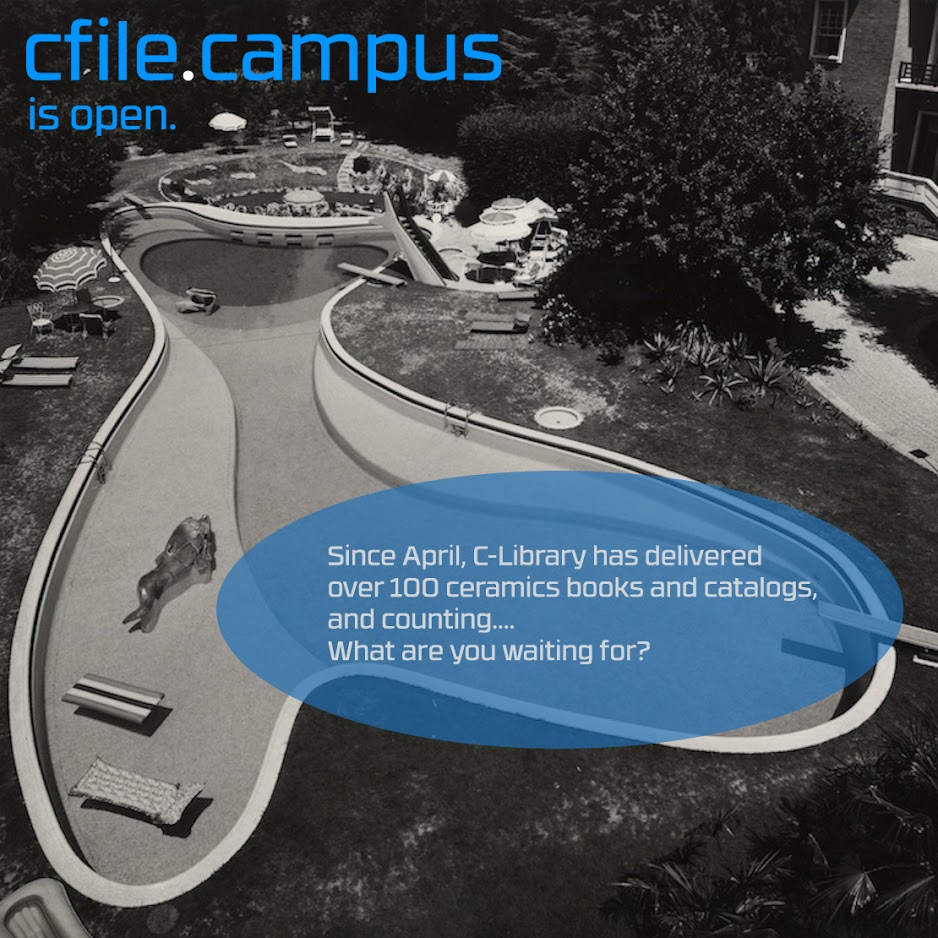We’re excited to announce that our member Campus is live! Through the rest of the week we will publish a series of articles that explain this exciting new chapter in Cfile’s development. We will describe the unique tools our Campus offers to its members (which we have dubbed Cfilers, a term picked by our readers). With your support we can build a global community that will sculpt the future of contemporary ceramic art.
Campus membership comes in two classes: Individual and Institution (for art schools, museums, etc.) Individual Cfilers can join for as little as $7.50 a month, Institutions for as little as $299 annually. Below is an overview of C-Catalog and C-Library. Click here to sign up for a free 30 days of access.
Cfile invests in your education as a student, professor, maker, collector, or curator in the ceramic arts. We believe it is impossible to understand contemporary ceramic art with little to no knowledge of the tradition that you are contributing to. Library is our ever-expanding archive of the top eBooks, catalogs, and key texts in ceramics, from the past to the present. We only include titles that we think have exceptional worth and value to the field. It is a one-of-a-kind resource for those looking to survey a particular gallery or artist’s legacy. Few could ever afford to build (including regular libraries) a resource so rich, broad, and current as we are building online. With catalog essays by top critics and page after page of gorgeous, glowing high-resolution images, we like to think Library is even better than reading the physical books! Seriously!
The global ceramics community must understand their very rich and diverse history, and today there are 95 (and counting!) publications in the library waiting to guide you in that journey.
Above Image: Virgil Ortiz, From Left: Siamese Twins, Opera Singer, Ringmaster, MC, 2011
Each week, cfile.daily features a publication that has just been added to Library. This week we are indebted to artist Virgil Ortiz, Charles King for his exceptional and insightful essay, and The Denver Art Museum for allowing us to put Revolt (2015) in our collection. If you are already a member, view the book, or begin your 30-day free trial today!
Click to Download your free sample of the Virgil Ortiz: Revolt catalog.
Revolt: 1680/2180: Virgil Ortiz
Lukavic, John P.; Held, Peter; King, Charles
Denver: Denver Art Museum, 2015
84 Pages
For Virgil Ortiz, the Pueblo Revolt of 1680 is a pivotal point in American history that few citizens can successfully offer even the most basic details of. And having grown up in Cochiti Pueblo, this is frustrated him. He aimed to take the story on, to make art that might retell the story of the Pueblo revolt and restore it to American consciousness.
As the story goes: After about 80 years of Spanish settlement in Santa Fe, Puebloans were tired of the infringement upon their land and culture. Seeking answers about the current drought and famine, the Spanish had arrested more than 45 Pueblo men on charges of “sorcery”. Among them was a man called Po’pay who, when he was released from prison, organized 46 Pueblo villages in defiance of the Spaniards. On August 10, 1680, the Pueblo people gained control of Santa Fe by stealing Spanish horses and cutting off the water supply to the city. Santa Fe remained the hands of the natives for only ten years, but the revolt is seen as a historic victory of Native Americans.

Left: Cochiti and Tesuque Pueblo figurines for sale, 1878-81, photo by Ben Wittick Right: Virgil Ortiz, Recreation of the Ben Wittick photograph with the Charles Bridge in Prague, Czech Republic as the backdrop. Figurines were made by Ortiz and family members.
When the Spaniards first settled near Cochiti Pueblo, the potters in the village began to sculpt large figures meant to poke fun at their proselytizing, Catholic newcomers. Funnily enough, the Spaniards found these objects cute and often purchased them from the craftsmen. Many of these were produced, but today they are nearly forgotten historic sculptures. When Ortiz learned about this tradition, he was struck by his ancestors’ use of clay for social commentary. Like his effort to rekindle interest in the Pueblo Revolt, he also wanted to revive or at least play into the tradition of “monos,” clay figures. Ortiz realized that he could implement this figurine tradition to configure the Revolt story. Throughout this book you will see a variety of conceptions of the monos.
Ortiz’s ouvre of figures take many forms, though not always ceramic. He is a figurative photographer too! His retelling of the Revolt manifested as a kind of science fiction narrative with characters and plot. Honestly, its riveting. In the words of Peter Held, catalog essayist:
“In his 2012 exhibition Velocity: The Future Captured in Clay, Ortiz’s figures become post-colonial nomads, migrating to uncharted territory in search of answers to future survival. Exiting terra firma, the character Ortiz calls Translator, unleashed from its topographical base, propels toward the third dimension to meet Po’Pay…. in his new guise. The artist, employing his signature tattoo-like, meticulously painted contouring patterns, on the emerging avatar, melds historic Cochiti monos figures with android robotics, providing authenticity to the narrative.”
His 2013 project Evolution, seamlessly fuses past, present, and future with time traveling, “whorling topknots” that are actually antennae, characters called Star People that show up in traditional creation stories, telepathy, and quite a whole lot more. If Ortiz’s goal is to recreate the Pueblo Revolt in a way that is interesting to a 21st century audience, I think he has succeeded.
Don’t loose sight of this incredible book with incredible essays and photographs that document the recent work of an incredible artist, Virgil Ortiz. If you are already a member, view the book, or begin your 30-day free trial today!
Click to Download your free sample of the Virgil Ortiz: Revolt catalog.




Add your valued opinion to this post.